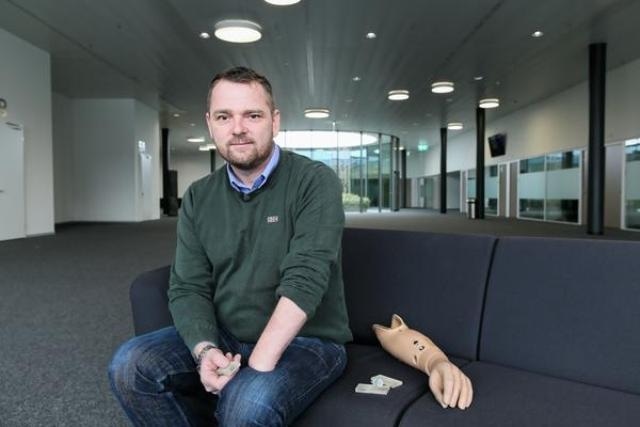Mar 9 2016
Researchers at Ecole polytechnique fédérale de Lausanne (EPFL) and Scuola Superiore Sant'Anna (SSSA) have developed a unique artificial fingertip that provides sophisticated tactile data to amputee Dennis Aabo Sørensen.
 An amputee feels rough or smooth textures in real-time — in his phantom hand — using an artificial fingertip connected to nerves in the arm. The advancement will accelerate the development of touch enabled prosthetics.
An amputee feels rough or smooth textures in real-time — in his phantom hand — using an artificial fingertip connected to nerves in the arm. The advancement will accelerate the development of touch enabled prosthetics.
The new bionic fingertip was connected to electrodes, which were surgically implanted to the nerves in Sørensen’s upper arm. It delivers clear tactile information to Sørensen, allowing him to sense smooth and rough textures in real time. This latest breakthrough will accelerate the development of bionic prostheses, with improved sensory feedback.
The technology would also benefit non-amputees, whose nerves can be activated to feel texture sensations without the necessity for surgery. This means touch-enabled prosthetics designed for amputees can now be designed and tested on intact people. This new technology was developed by Silvestro Micera and his research team from EPFL and SSSA, in collaboration with Calogero Oddo and his research team at SSSA.
Amputee Feels Texture with a Bionic Fingertip
The study findings have been reported in the journal, eLife.
The stimulation felt almost like what I would feel with my hand. I still feel my missing hand, it is always clenched in a fist. I felt the texture sensations at the tip of the index finger of my phantom hand.
Dennis Aabo Sørensen
Sørensen is first in the world to feel texture sensations with a bionic fingertip.
This development was achieved by connecting the nerves in Sørensen's upper arm to an artificial fingertip fitted with sensors. The movement of the fingertip was controlled by a machine over different parts of plastic imprinted with varied patterns, either rough or smooth. As and when the fingertip was allowed to move across the textured and patterned plastic, an electrical signal was produced by the sensors. This signal was converted into a range of electrical spikes, which mimic the nervous system language, and was finally transmitted to the nerves. Sørensen could differentiate between smooth and rough surfaces 96% of the time.
In a similar study performed in the past, Sorensen's implants were joined to a sensory-improved prosthetic hand. This enabled Sorensen to feel both softness and shape. In the latest publication that appeared in the eLife journal, a higher level of touch resolution was achieved by the artificial fingertip.
Simulating touch in non-amputees
The same experiment involving coarseness testing was carried out on non-amputee individuals, without the necessity of added surgery. The tactile data was transmitted through fine needles, which were momentarily attached to the median nerve of the arm via the skin. It was noted that these non-amputees were able to differentiate the roughness in textures 77% of the time.
It was still unclear if the data about the touch felt from the artificial fingertip is similar to the actual touch sensation experienced from a real finger. This angle was tested by studying and comparing the brain-wave activity of the non-amputee subjects by using the bionic fingertip and then by using their own finger. Brain scans, which were later collected through an EEG cap fixed on the subject's head, showed a similar effect in the activated parts of the brain.
The study showed that the texture information transmitted by the needles is same as that of the implanted electrodes. This provides researchers with new avenues to speed up the development of prosthetics with enhanced touch resolution.
This study merges fundamental sciences and applied engineering: it provides additional evidence that research in neuroprosthetics can contribute to the neuroscience debate, specifically about the neuronal mechanisms of the human sense of touch. It will also be translated to other applications such as artificial touch in robotics for surgery, rescue, and manufacturing.
Calogero Oddo, BioRobotics Institute, SSSA
The study was performed by SSSA and EPFL along with Università di Pisa, Università Cattolica del Sacro Cuore, IRCCS San Raffaele Pisana, and Università Campus Biomedico.
The research was partly funded by EU Grants TIME, NEBIAS and NANOBIOTOUCH, by the Italian grants NEMESIS (funded by the Italian Ministry of Health), PRIN/HandBot (funded by the Italian Ministry of Research), and PPR2 (funded by the National Institute for Insurance against Industrial Injuries), by the ENABLE project funded by the Wyss Center for Bio and Neuroengineering, and by the Swiss National Competence Center in Research in Robotics.